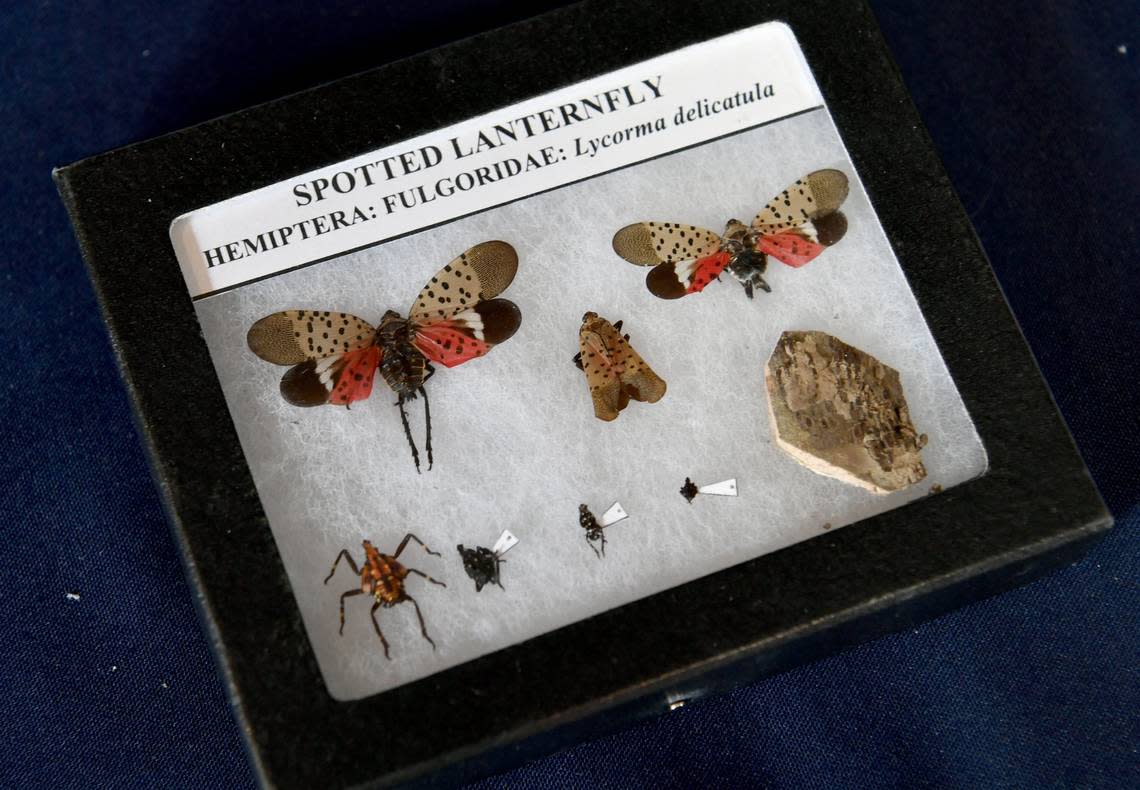This invasive pest could soon make its way to Kentucky. Here’s what to do if you see it
Spotted lanternflies have been reported in 14 U.S. states so far, and while Kentucky hasn’t yet been struck by the invasion, the pests could make their way to the commonwealth soon.
People have reported spotted lanternfly sightings in Connecticut, Delaware, Indiana, Maryland, Massachusetts, Michigan, New Jersey, New York, North Carolina, Ohio, Pennsylvania, Rhode Island, Virginia and West Virginia.
National Pest Management Association chief entomologist Jim Fredericks said one of the areas where spotted lanternflies have been reported is Switzerland County in Indiana, which borders Kentucky.
“We expect that the spread will be pretty wide. Kentucky is certainly within the realm of possibility,” Fredericks said.
The commonwealth offers prime real estate to the pests, which threaten apples, grapes, cherries, nectarines and several native plants and trees.
“People in Kentucky should definitely be vigilant because the habitat is right, all of the food plants that it likes the best are there,” Fredericks said.
But why are spotted lanternflies such an issue and what should you do if you see one? Here’s what to know.
Why are spotted lanternflies so problematic?
The spotted lanternfly arrived in the U.S. in 2014, and it’s native to China and some of India, Vietnam, Japan and Taiwan. While China’s landscape has sufficient natural enemies to keep the spotted lanternfly population under control, the U.S. doesn’t.
“Without its natural predators to keep it in check, these plant-feeding insects can reach kind of pest status very quickly and can cause severe damage to these plants,” Fredericks said. “And so it really has become a big concern in many states now.”
The insect often boasts unique patterns and coloration.

“But don’t let its good looks deceive you, because it definitely can put some of our really important plants at risk here in the United States,” Fredericks said.
As the spotted lanternfly can hurt important plants and trees, such as maples, oaks, willows and poplar trees, it’s important to take action if you see one. Especially if you’re traveling to an area where people have reported the pests, Fredericks said to keep an eye out.
“If you see a spotted lanternfly, squash it,” Fredericks said. “It’s best to just try to eliminate as many of these things as possible.”
Spotted lanternflies aren’t very good at flying, Fredericks said, so their spread in the U.S. has primarily taken place through transported egg masses.
The pests lay eggs in the fall, and they may appear like a muddy mass cemented onto a surface like a picnic table or vehicle. A mass could contain anywhere from 30 to 50 eggs, Fredericks said, and you should scrape them off and destroy them if you find them.
Spotted lanternfly in Kentucky
While there’s no guarantee the spotted lanternfly will come to Kentucky, if you happen to see one, Fredericks said it’s important to report the sighting to the commonwealth’s Department of Agriculture.
“If you’re in a state where these haven’t been reported and you suspect you see a spotted lanternfly, then it’s even more important to report, because that could very well be the first known report within that state,” Fredericks said.
The spotted lanternfly could potentially threaten wine and Christmas tree production, apple growing and the commonwealth’s forest industries, according to the University of Kentucky.
“Their high numbers on host plants and the recruitment of black sooty mold and stinging insects by honeydew production can decrease the recreational value of parks and backyards that are infested,” the university’s website reads.
In addition to the harmful effects on nature, UK entomologists note the potential regulatory responses to an infestation could negatively affect commonwealth residents’ finances and quality of life. These regulations could include restrictions on lumber transportation, quarantines or required permits to travel outside infested areas.
Do you have a question about wildlife in Kentucky for our service journalism team? We’d like to hear from you. Fill out our Know Your Kentucky form or email ask@herald-leader.com.
